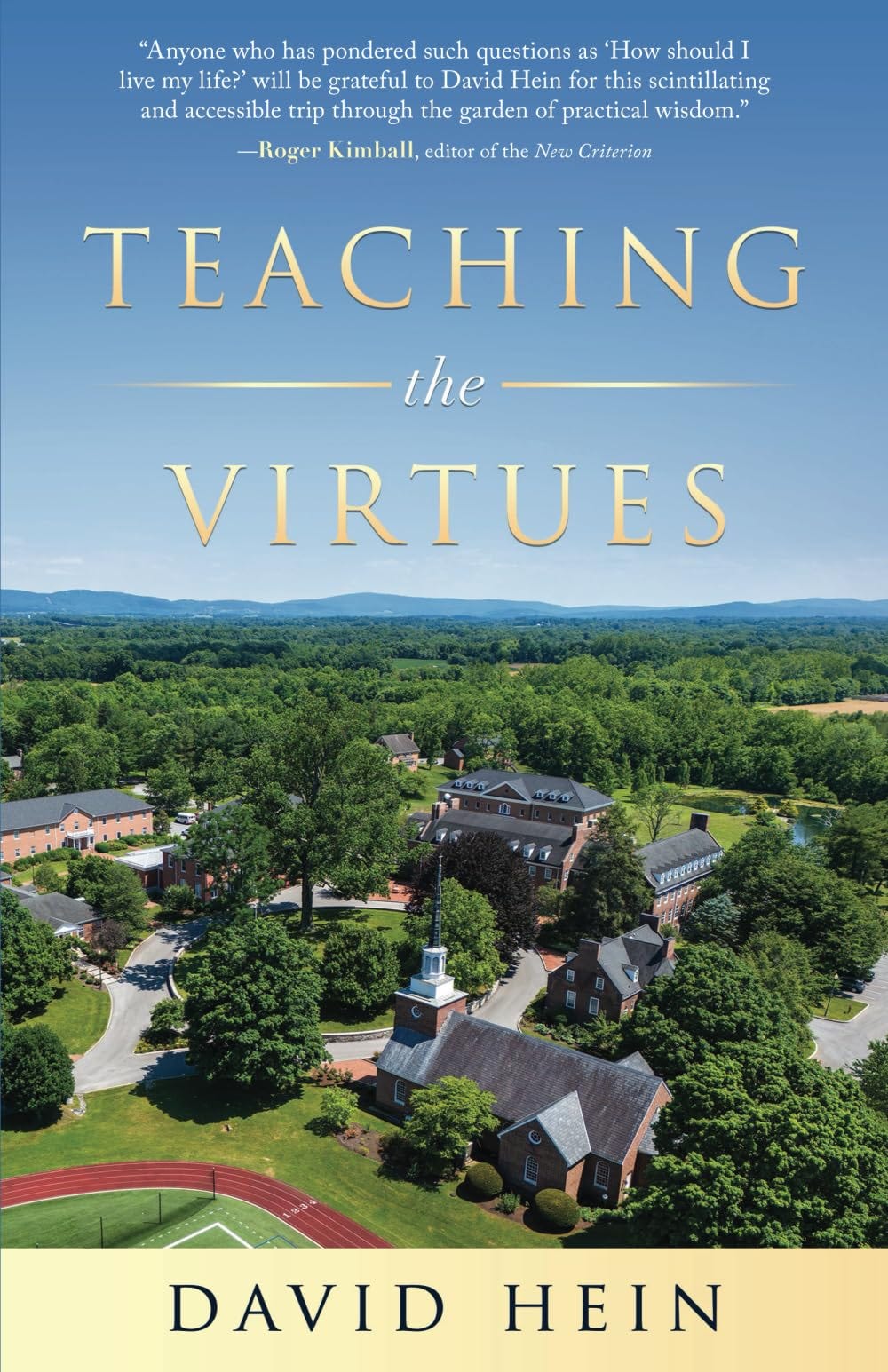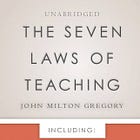As an Amazon Associate I earn from qualifying purchases
Teaching the Virtues. By David Hein. Mecosta House, 2025.
In 1987, Russell Kirk published Wise Men Know What Wicked Things Are Written On the Sky, his only sustained treatment of education amongst his many books. In it, he included a chapter titled “Can Virtue Be Taught?” which functioned as a kind of false lead as his criticism was aimed at something more than a pedagogical inquiry. It is fitting then that the first book to be published under the new Mecosta House publishing, operating from Kirk’s beloved Piety Hill in Michigan, is David Hein’s Teaching the Virtues. Hein’s book takes after Kirk’s essay in the sense that it is not a pedagogical manual on how to incorporate the Virtues into the classroom nor about how to implement policies which will enhance character education in schools. Instead, Teaching the Virtues functions as an introduction to the premise that virtues can be taught (though Hein adds some caveats) and that everyone ought to take this idea seriously.
The book is broken up into two parts, one about schools specifically and the other about the virtues themselves. The parts overlap at points so that Hein is never in danger of abandoning one side of the debate to the detriment of the other. In part one, Hein introduces a metaphor which informs the rest of the book: ball bearings. While Hein only spends two pages outlining this idea, it is the way in which he approaches teaching the virtues and thus should be remembered throughout the rest of the book. Ball bearings are composed of metal balls contained within two rings, an inner and an outer, and these devices reduce friction in machines to prolong usefulness and avoid catastrophic failures. Hein turns this into an analogy for schools, with the inner ring being the school life (i.e. curricula, sports, discipline) and the outer ring being the larger commitments of the school (i.e. Christian orthodoxy). The metal balls which keep the rings from colliding are the virtues. This image helps explain how Hein can find significant commonalities between educators such as Henry Coit, John Dewey, and Simone Weil (33, 39) and also why he views writing as a moral act in and of itself (41, 53). It also helps make the connection for Hein from the curriculum to writing and then on to the plethora of honor systems which are prevalent at so many Christian schools (58, 72).
After discussing a bit of the history of schools, a bit about what schools teach, and a bit about how they encourage honor, Hein moves to more directly address the virtues in the second part. He outlines up front that his aim is to offer some thoughts on teaching the virtues rather than defining them, though the two things are obviously connected (75). He gives brief examples of the four cardinal and three theological virtues, along with short sections on three virtues more commonly used in twenty-first century educational dialogue: gratitude, stability, and patience (95-97). Hein then explores three exemplars of virtue: George Washington, Hannah More, and Book T. Washington. This chapter also provides background on the life of each figure, how they exemplified specific virtues, and also some thoughts on teaching about these complex yet instructive people. The chapter that follows offers a similar excursus through literature and film, exploring the novels All the King’s Men (1946) and Darkness at Noon (1941) along with the westerns Ride the High Country (1962) and The Hanging Tree (1959). These two chapters aren’t attempting to limit what teachers use in discussing virtue, but rather offering materials that can be used in the classroom or which might inspire teachers to come up with their own historical figures, novels, and films to promote similar discussions (161). While Hein spends most of the book writing to Christian schools who may not be sure about teaching virtue in the classroom, he most explicitly address this in the final chapter which is devoted to the trait piety. Hein uses a final exemplar to explore how piety unites the virtues by looking at the life of George C. Marshall (168). Hein closes the book with a brief appendix defining the virtues and a short piece of advice on how to make inroads with virtues in the classroom (177-180).
Teaching the Virtues, then, is best thought of a series of case studies, exploring the education of individuals and how their lives were shaped by specific virtues. This is an important element to bear in mind, as well as who the primary audience for this book might be. Classical Christian educators, folks who have been in what is commonly called the CCE (Classical Christian Education) world, might come to this book hoping to find hands-on, practical advice on how to make the virtue instruction they are already attempting even better. And for those readers, there is limited benefit here. Benefits are still present in the book, such as Hein’s marvelous explanation of writing as a moral action or the various figures he illuminates, which can be an aid to even the most seasoned CCE pedagogue. But teachers should come to the book understanding that if you’ve been in a Classical school for fifteen years, this book offers fodder for thought rather than a best-practices workshop.
I think the folks who will get the most from this book are of two kinds: those who are interested in virtue education but do not work at schools who prioritize it, and those who are skeptical that virtue matters to education. It may seem strange that such disparate groups would be grouped together here, but Hein’s strengths specifically speak to such readers. For those who want to explore virtue education in public schools, charter schools, or religious schools which functionally are public schools with a Bible course, Hein offers some excellent thoughts on how to take steps towards crafting a virtue-oriented classroom. For instance, any of the above-mentioned schools would allow a teacher to use All the King’s Men in various courses, and Hein’s exploration of how virtue shapes the story could be adapted and implemented without much objection (140-142). In a similar fashion, the virtue-skeptical instructor will be surprised to find that John Dewey might be an ally for this idea, and Hein deftly advances the argument that modern skepticism is on shaky ground in its rejection of virtue education (32-34).
While I think the book has many positive elements, I do wonder if the ball bearing metaphor can sustain the argument that Hein offers. All such images break down when pushed too far of course, so readers should be wary about overusing the image. Still, I am uncertain that the virtues can serve as the thing which enables smooth connections, reducing friction between the curriculum and the core tenets of an institution. They may indeed turn out to be that, but I worry that any curriculum that doesn’t treat the virtues as the foundation of education will find that virtue education might increase tension rather than lessening it. For instance, Hein provides examples of virtue education can be incorporated into the Natural Sciences and Mathematics, but his suggestions rub against what many parents want in such classrooms, namely content expertise that leads to good test scores (35-36). Could Hein’s approach decrease this tension and restore the virtues to their proper place in every subject? I would love for that to be so.
In the end, I stand with Hein as an educator who wants “the substance of the virtues [to become] truths to live by” (23). And I, like Hein, pray that our Lord will “make us continually to be given to all good work” (176). An education that accomplishes this would be virtuous indeed.
Sean C. Hadley is a graduate of New Orleans Baptist Theological Seminary (MDiv, 2017) and Faulkner University's Great Books program (PhD, 2023). His writings have been published in outlets such as The Imaginative Conservative, Touchstone magazine, and The Hemingway Review. Since 2012, he has been a teacher in both the classical Christian and the collegiate classroom. Currently, Sean is the Postdoctoral Fellow with the Classical Education Research Lab.






